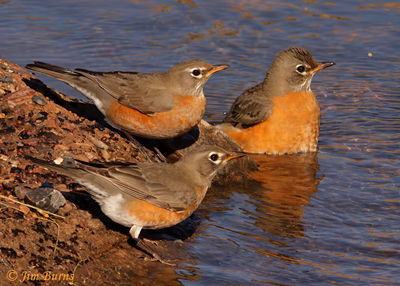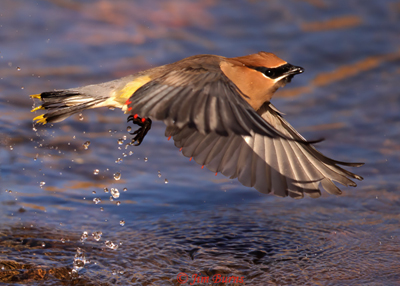
To begin at the beginning, as I was growing up in the Midwest, the very first species I remember actually seeing and hearing named was Cedar Waxwing. As I was only a preschooler at the time, I can certainly not claim these ethereal beauties were my ”spark” bird because I did not become a serious birder until a young adult out of college and, in truth, never saw these frugivorous nomads again for over twenty years.
Through my school years, however, the bird with which I became most familiar was our common yard bird, American Robin. They nested in our next door neighbor’s huge elm tree, and all summer long we heard their joyous, rollicking vocals and watched them as they prospected for worms and visited our bird bath. So familiar and common in fact, that when I first began looking for birds I hardly gave robins a second glance.
Waxwings, of course, always get a second look here in Arizona because they do not breed in the state, are uncommon in winter, and being nomadic rarely show up in the same place two years in a row. In my forty years here I had records from only three disparate locations, all late summer and autumn—Oak Creek, Kitt Peak, and Boyce Thompson Arboretum.
Though robins began getting my attention when I took on a Breeding Bird Survey route in the White Mountains where their song can seem ubiquitous in May and June, I had only two records from here in the Valley. One was in winter as I bicycle commuted to work. The second was a single, seemingly lost individual in October of 2021 at my local patch, a sparse desert park where I had birded for forty years without seeing a robin. But, an irrigation canal runs through it.
Along the canal is a huge old Tamarisk which every winter attracts the local Cooper’s Hawks, both adults and juvies, that hide out and loaf there before dropping into the water to bathe. At sunrise on December 10 I threaded my way slowly behind trees and rocks toward the Tamarisk hoping to catch a Coop at the water. No such luck, but as I sat down on a small rise overlooking a wide curve in the canal I heard a vaguely familiar call.
No one has ever accused me of being an ear birder, but if I hear vocalizations often enough they sometimes register, and for sure I am conversant with everything the common birds at my patch have to offer. This was different—“Shriek, cluk, cluk,” then a whinny. As I scrolled mentally through my rolodex of vocals trying to place this sequence, a robin dropped from a nearby Mesquite into a Creosote bush beside the canal. Of course, I thought, as recognition dawned.
Glancing up I saw there was a handful of robins at the top of the Mesquite basking in warmth of the rising sun along with the ubiquitous starlings. One by one both species dropped to the Creosote, then walked warily to the water to drink. Interesting, but since I didn’t need photos of these common species, and when a hiker spooked the small flock of robins, I headed home to record my third sighting of American Robin for the Valley.
I didn’t return to the scene until sunrise on Christmas Eve morning, not expecting much and knowing the park would soon be overrun with weekend fishermen and dog walkers. As I came over the hill, though, I heard robins again, recognizing the sound instantly this time, mainly because it was all around me—several in the treetop catching first light, a few already in the bushes above the canal, many flying back and forth over the hill.
There is nothing like the magic low light in the hour after sunrise to enrich and intensify the colors of nature, and what was happening around me was spectacular orange chaos. I sat down carefully on the rise, camera in hand and quickly realized, perhaps in their huge numbers and constant jousting with one another, the robins seemed largely oblivious of me.
At one point I counted fifty in the staging tree, another fifty strung out along the canal’s edge or splashing in the water, tens more passing overhead or preening in the bushes, some only yards away from me. I’d guesstimate there were now several hundred robins in the park, drab females, some first year birds, others textbook mature males, spectacular with the contrast between orange breast and coal black heads.
Suddenly a large flock of starlings flew over, something--something smaller and brighter--strung out through the center of their dark cloud. I raised the lens and fired off “spray and pray” shots, looked at the back of the camera, and received a jolt of joy. Waxwings! In the Saguaro desert!? I knew if I just sat and waited I might get every shot I’d ever imagined of these beautiful nomads. I did and I did.
This amazing avian spectacle lasted over an hour, robins and waxwings together, drinking, bathing, squabbling, preening. When the starlings would flush, the waxwings would leave with them, but the robins barely looked up. And the waxwings, perhaps two dozen, a few among them fully mature adults sporting the red wing appendages, always came back with their starling escorts.
Thankfully, as my legs began to cramp up, by late morning the action began to wane, and I staggered to my car knowing I didn’t need to unwrap any presents the next day. I had already received my Christmas gift. The joy of birding.